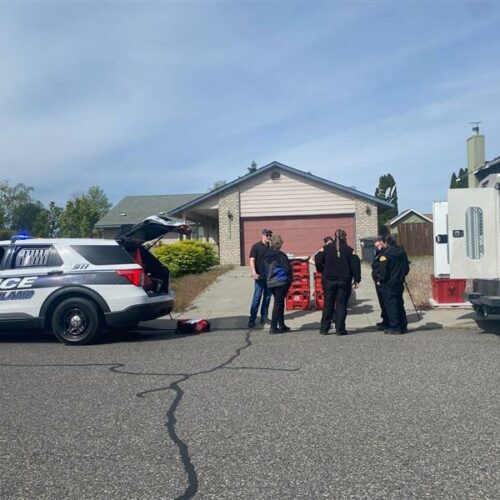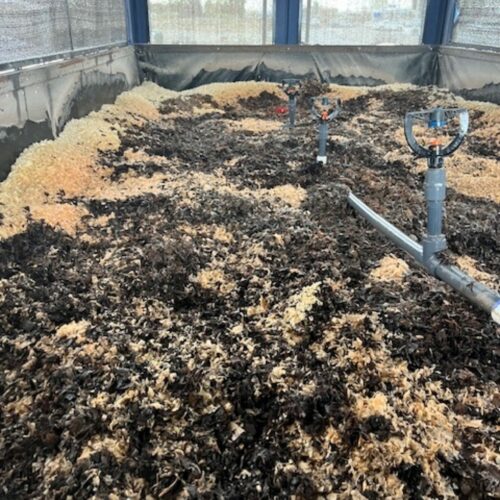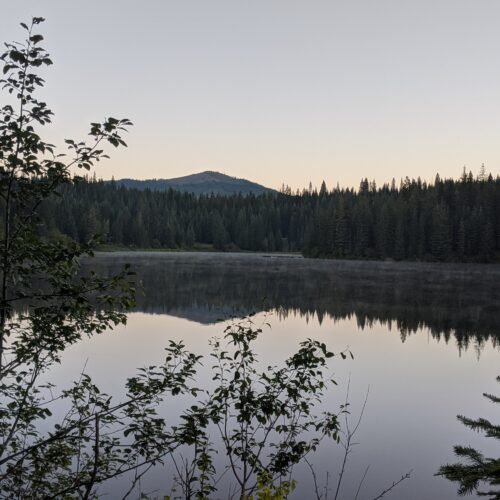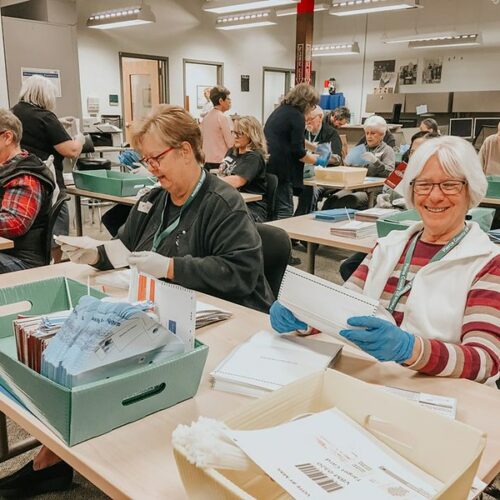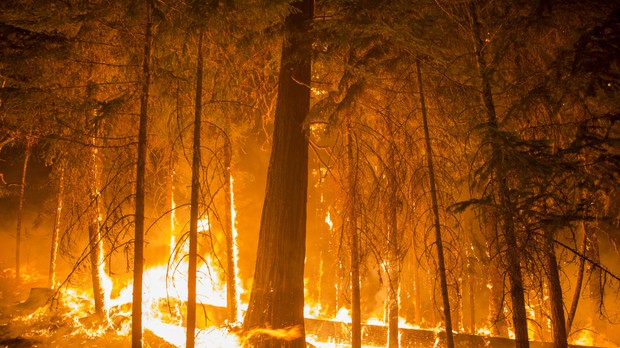
Can ‘Moneyball’ Fix How The West Manages Wildfire?
Listen
“Deliberate use of fire, as well as control of wildfires, must be an integral part of the planning process.” — Thomas C. Nelson, Deputy Forest Service Chief, in 1979.
The U.S. government spent a record $2.9 billion fighting wildfires last year. This year is shaping up to be another costly fire season. It doesn’t have to be that way.
Up against pressure from politicians and the public, risk-averse bureaucracies drive their fire managers to spend millions of dollars suppressing wildfires that pose relatively low risk compared to the benefit of letting them burn. Some of those fires are far from homes in remote wilderness. Others are closer to communities in national forests, where under the right conditions they could, in fact, reduce costs and risks to life and property by stunting the spread of future fires.
The U.S. Forest Service and other state and federal agencies fight those fires often knowing that doing so can be counterproductive. Scientific evidence that’s been accumulating since at least the 1970s points to the ways that suppressing fire leads to unhealthy forests. It incentivizes the construction of more homes in fire-prone wildlands. And it sets the stage for the bigger, costlier blazes that have dominated headlines in recent years.
“We’re still digging in our heels like we always have and we’re just going after it more and more and more, rather than backing off and taking a different assessment,” said Chris Dunn, who studies fire at Oregon State University.
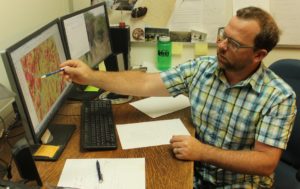
Oregon State University professor Chris Dunn examines a map of the likelihood of success for fire suppression in southern Oregon. Dunn is part of a Forest Service team using data to improve decision-making and risk assessment. CREDIT: TONY SCHICK/OPB
Dunn, who fought fires for eight years before getting his doctorate, now works on a Forest Service risk management science team trying to change the agency’s course after 100 years of all-out fire suppression.
“We’re trying to tackle that problem,” Dunn said. “Only, that problem is deep.”
Over several months, EarthFix has analyzed government documents and data, reviewed scientific literature and conducted more than a hundred interviews to find out why firefighting costs have soared and why, 30 years after the famous Yellowstone National Park fires, the West appears no closer to solving its wildfire conundrum.
The reasons are many: Summers became hotter and drier. Fire season grew longer. More people built homes in the woods. Decades before any of that, the Forest Service, the country’s leading wildland fire agency, recognized the need to change our approach to the risks of wildfire. But since then, it has struggled to change a system that perpetuates the same kind of firefighting that helped create the current era of extreme fire.
1975: A Southern California Problem?
Mike Edrington had a nagging fear of the fire to come.
The year was 1975. He was working as a district ranger in the Front Range mountains outside Denver, debating with colleagues whether the whole of the West would someday be overcome by fire.
They were putting out fires as fast as they could in those ponderosa pine forests. And people kept moving to those woods. But they told themselves fire catastrophe was a Southern California problem. It would never happen to the rest of the West.
“Well, it has,” said Edrington. He now lives in Gresham, Oregon, after retiring as Northwest regional fire and aviation director for the U.S. Forest Service and Bureau of Land Management.
Over the next 40 years of his career, Edrington and the rest of the wildland fire community reckoned with the fact that a century of suppressing fire ended with less control of it.
In many places, aggressive wildfire suppression will always be needed so long as homes, public water sources and other valuable assets occupy fire-prone forests and rangelands.
But after being deprived of fires both large and small for a century, naturally patchy forests grew thicker with fuel-cluttered forest floors. The scars of old burns, which dotted the land and kept many fires smaller and more predictable, disappeared.
We shifted the balance toward more extreme fires, scientists say. Now, when fires escape firefighter attacks they find unprecedented fuel to burn.
In the past two decades, Oregon alone has seen 15 fires surpass the 100,000 acre mark, big enough to meet the government’s definition of a megafire. The federal government’s fire-suppression bills for the past 10 years add up to nearly $17 billion. That is more than double the amount spent in the 1980s and 1990s combined.
“Much of the destruction that we are currently seeing could actually have been avoided,” says Wenatchee, Washington-based fire ecologist Paul Hessburg, in a TED-styled lecture he now gives on tour for the Forest Service.
Forest Service leadership is now embracing this message: We were wrong.
“Instead of waging a losing war on wildfire, we are learning to live with fire,” acting U.S. Forest Service Chief Vicki Christiansen wrote in a recent letter in The Oregonian/Oregonlive.
The message isn’t new.
1988: The Yellowstone Awakening
In 1988, a series of fires burned nearly 800,000 acres in Yellowstone National Park. They captured the attention of the nation and awakened it to the inevitable, necessary role of fire in the woods.
Edrington served as an area commander on the fires. He summed up the lesson learned: “A fire in a natural environment is neither good or bad. What makes fire disruptive is people.”
Nearly a full decade before Yellowstone, in 1979, the deputy chief of the Forest Service was already denouncing our approach to fire.
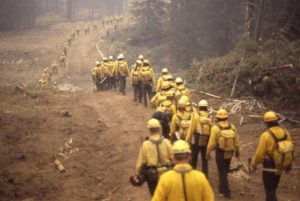
A line of wildland firefighters marches through the woods during the Yellowstone fires of 1988. The massive complex of fires, which burned more than 790,000 acres, was a transformative moment in the country’s view of wildfire. CREDIT: NATIONAL PARK SERVICE
“Each fire was to be put out as quickly as possible,” wrote Thomas C. Nelson in the Journal of Forestry. “That conclusion, probably proper in its day, does not fit the resource-management needs of the 1980s.”
His paper announced a new policy to deliberately use fire. In practice, it was ignored.
Over the years, the Forest Service invested in research on fire ecology and risk management. More so than states and some federal agencies, it educated the public on the importance of fire and developed flexible policies.
Indeed, the agency is now criticized for not being aggressive enough fighting fires.
“Our policy is to use every tool we have to improve landscape conditions, evaluating and managing the risks in conjunction with our state and other partners,” acting U.S. Forest Service Chief Christiansen wrote recently in response to that criticism.
But overall, the country’s largest wildland firefighting agency has been slow to address systemic flaws that perpetuate bad fire outcomes, according to interviews with fire scientists, policy advocates and former wildland firefighters.
For example, many of the plans that govern national forests reflect outdated views and call for the suppression of all fires. Agency staff say those plans, which are due for updates, foil attempts to manage lands properly.
The Forest Service and the Interior Department agencies still struggle to even measure their progress toward reintroducing wildfire.
They continue to measure themselves by an ability to keep as many fires as possible under 300 acres. The Forest Service boasted a success rate of 97 percent last year.
Meanwhile, the government’s own scientists suggest most wildfires — potentially 70 percent of them — would likely burn out before ever reaching that size. For all the investment in fire suppression, the current success rate at keeping fires under 300 acres is only marginally higher today than historic figures indicate it was in the 1910s when the job was done by amateurs with axes and horses.
In other words, the government spends millions and claims credit for containing many fires nature would contain by itself.
2002: Still Suppressing Every Fire
Flaming fronts and whirling fires dominated the news and in the end, the Biscuit Fire of 2002 had the look of a wasteland. It cost $150 million and burned 500,000 acres in southwest Oregon.
In hindsight, Joe Stutler sees it differently.
“I’m thinking jeez, that’s pretty damn good,” said Stutler, an incident commander on the fire who now works for Deschutes County. In his eyes, it was a bargain.
About a quarter of the land was severely burned. The rest, he said, might as well have been prescribed.
“If somebody gave me $150 million and told me to treat a half a million acres with 75 percent success in that country, I couldn’t do it,” he said. “People instead focus on when it’s going to be contained. And when is the smoke going to end.”
Top fire scientists say the West needs to burn about five times current rates if we want to reduce our risk of extreme fire, and that the only way to get there is to embrace the role of wildfire alongside thinning and prescribed burning.


Stutler says we could lower fire costs significantly by the end of the next decade.
“Because we’ll say, ‘You know, this is burning in an old burn scar, or it’s burning in a patchy spot that needs it,’” he said. “So you don’t throw the world at trying to stop something that’s inevitable anyway.”
Current practice rarely lets that happen.
In his four years as the regional forester over Oregon and Washington, Jim Peña cannot recall a wildfire his staff managed for what he called beneficial use: monitoring it as it burns for the sake of a healthy forest and a more resilient landscape.
“We were actively trying to suppress all the fires we had,” said Peña, who retired in July. “Some of those fires may have done us some more benefit had we allowed it to burn.”
There were, in fact, a few such cases in Peña’s region, and fire managers do have the discretion to use a lighter touch even on full-suppression fires.
But during summer months, Peña said he directed staff not to come to him for permission to let a fire burn. He worried about allowing those fires to grow and forcing evacuations, smoking up towns or tying up engines, hand crews and aircraft he needed elsewhere instead.
“I don’t believe what we’ve seen in our burning conditions would allow us to accept that level of risk,” Peña said. “I know from this year, very few of the communities that dealt with a large fire for two months wanted to hear, ‘This was a great fire, look at all the positive things that happened.’”
More than 71,000 wildfires ignited across the United States last year, according to the National Interagency Fire Center. The government does not tally how often its fire managers are trying strategies other than full suppression on those.
Incident reports analyzed by EarthFix suggest there were upward of 500 fires last year in which managers used a strategy other than full suppression. Those other tactics can include monitoring the fire without attack, confining it to a larger pre-defined area or targeting firefighting efforts around specific buildings or other assets.
Many states, like Oregon, have an aggressive suppression-only policy on their lands. Federal agencies have flexible policies but often bump against those state lands. They also remain dogged by the perception that using fire means letting it burn out of control.
In Oregon and Washington, fire starts are common in areas where new U.S. Forest Service calculations show fire to be a low risk or net benefit, depending on the time of year. But the true extent of missed opportunities to use wildfire remains a mystery.
In all but a few cases, agencies attack fires without first utilizing full risk analysis or decision support tools, which are geared toward large fires that escape initial firefighting efforts. Thousands of fires are suppressed without the most thorough look at whether they should be in the first place.
“We’re fighting blindly all these unplanned ignitions. Leaping before we’re looking, really,” said Timothy Ingalsbee, a former wildland firefighter who founded the advocacy group Firefighters United for Safety, Ethics & Ecology.
2017: ‘The Fire That Could Have Been’
Last summer, Erin Phelps saw a chance to get ahead of the problem.
Lightning ignited a stretch of Montana near Missoula she’d already been eyeing for a prescribed burn. Surely, if ever there was a chance to let fire do its thing, this was it.
“Man, what a great opportunity,” Phelps, a district ranger on the Lolo National Forest, told reporters at a presentation in Missoula this past spring.
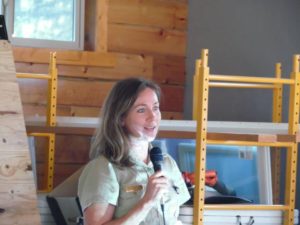
Erin Phelps, Ninemile District Ranger on the Lolo National Forest in Montana, speaks at a community briefing during the 2017 fire season. CREDIT: LOLO NATIONAL FOREST
The fire was behaving exactly as she wanted, burning up undergrowth and staying in check.
But 2017 was one of Montana’s most intense fire seasons. It dragged on and towns filled with smoke. Fires killed two people that year.
That kind of damage is exactly what Phelps wanted to use fire to prevent. Instead, it prevented her from using the fire: ultimately, just a few weeks after it started, she decided to put it out.
“It’s the fire that could have been,” she said.
When a fire burns a long time, envelops a city in smoke, or threatens homes, decision-makers like Phelps often take heat from politicians and the public over why it wasn’t stopped sooner. Rarely do they get such criticism for suppressing a fire they could have backed off instead.
This creates a feedback loop that results in worse fire outcomes.
“The uncertainty and societal pressure lead many fire managers to being risk-averse and thinking that suppression is the safest decision,” said Dave Calkin, an economist and research forester with the U.S. Forest Service in Missoula. In 2015, Calkin co-authored a paper on the negative consequences of the current incentives for fire managers to aggressively suppress all wildfires.
In many cases, suppression is the right decision but not always, Calkin said.
“The accumulation of the ‘safe’ decision on almost all fires leads to worse outcomes,” he said.
Two fires from Oregon last summer offer an example of the feedback loop.
In the Mount Jefferson Wilderness, the U.S. Forest Service spent $39 million suppressing the Whitewater Fire and still ended up facing accusations of letting it burn out of control, largely because of a perception it wasn’t aggressive enough at the outset.
That same summer the Forest Service suppressed a remote fire in the Hells Canyon Wilderness, at a relative bargain of $600,000. It was covered only in the local paper, the La Grande Observer, to which a fire manager gave the following reasoning: “there’s nothing going on in the region so we hammered it.”
With pressure to keep cost down and little certainty over where and how a new fire might spread, fire managers usually are aggressive when a fire is smaller and cheaper to fight.
This can lead to overspending. One economic analysis by a former U.S. Forest Service researcher showed suppression in California to be a net loss on most fires.
Suppressing too many fires also has the effect of a payday loan: The short-term gain from suppression conditions the landscape for future fires burning in extreme conditions. It all but ensures the toll will rise.
2018: Moneyball For Fire
This past spring, Forest Service analysts put the finishing touches on a project that could help break the loop.
At the agency’s offices in downtown Portland, Rick Stratton showed off maps and charts detailing where fire in the Pacific Northwest is riskiest and where it’s most beneficial if allowed to burn.
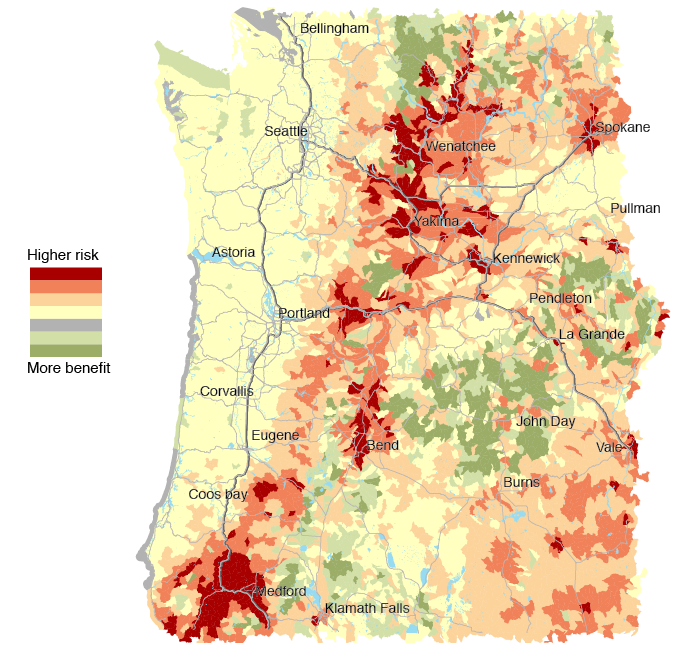
This is the latest use of cutting-edge wildfire risk assessment, an effort within the U.S. Forest Service to bring data-driven decision-making to wildland fire management.
Pick your spots to re-introduce burning and maybe that 100,000-acre “megafire” won’t seem so devastating, said Matt Thompson, who along with Calkin authors much of the Forest Service’s work on the subject.
“Those extreme events are still going to happen. But maybe if we capitalize more when things are moderate we can at least dampen their impact,” Thompson said.
This requires a tolerance for risk and a willingness to trust the process. Good decisions will inevitably include some bad outcomes.
“Some of the areas that are most in need of more burning are also the areas where it might be most risky to re-introduce fire,” said Thompson. “It’s one thing to take a hands-off approach to a fire that’s in a very remote wilderness area — and it’s challenging even to get people to be comfortable with that — let alone fires closer to things like watersheds and homes.”
Thompson said they often call their work “Moneyball for fire” — a reference to the 2003 book chronicling the Oakland Athletics’ attempt to outsmart richer baseball teams by using advanced statistics.
They studied the analytics revolution in sports, hoping to copy its impact in their own field. In sports, as in fire, decision-making was a job reserved for the trained eyes and gut instincts of grizzled veterans.
The Forest Service is now developing Risk Management 101 courses for fire officers. Calkin and others are designing a new risk management doctrine to guide the agency. During fire season, they are experimenting with on-call analytics teams to assist incident commanders.
The risk-assessments of Oregon and Washington are the broadest use of these wildfire analytics to date. It took two years to complete, Stratton said.
“Several years ago, we couldn’t have even done what we just did,” Stratton said.
Fire managers can now use it to target fuels treatments and help prioritize where they put resources. Soon, Calkin’s team will match that effort with calculations of where suppression efforts are likeliest to succeed. And then, they can design the ideal response to a fire depending on when and where it happens.
It will become the tool the U.S. Forest Service needs if it’s going to use fire, not just fight it.
Note: Reporting for this story was supported by the Institute for Journalism and Natural Resources.
Related Stories:
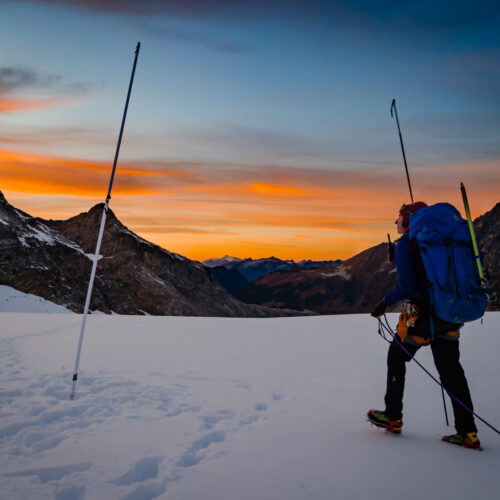
Spring snowpack levels in North Idaho lowest in 40 years
Erin Whorton, a hydrologist for the Natural Resources Conservation Service, measures snow on South Cascade Glacier in Washington. (Credit: Erin Whorton / NRCS) Listen (Runtime :58) Read The snowpack in… Continue Reading Spring snowpack levels in North Idaho lowest in 40 years

Investigadores de Oregón ayudan a viticultores a afrontar el cambio climático y el humo
Investigadores están desarrollando revestimientos especiales para proteger los vinos del noroeste de cualquier sabor a humo. Continue Reading Investigadores de Oregón ayudan a viticultores a afrontar el cambio climático y el humo
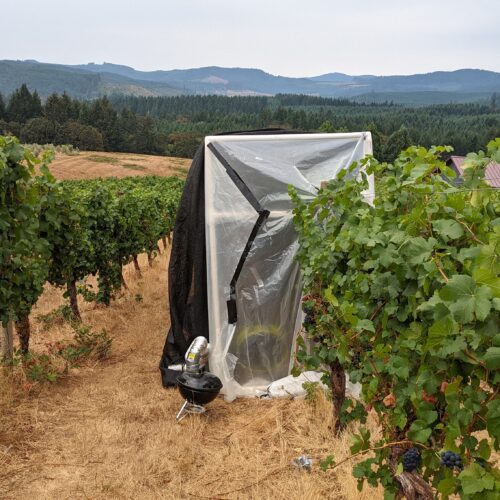
Oregon researchers hope to provide new tools to help wine growers address climate change, smoke
Pinot noir grapes at Oregon State University’s Woodhall Vineyard undergoing smoke experiments. (Credit: Sean Nealon / OSU) Listen (Runtime :54) Read Researchers are developing special coatings to protect Northwest wines… Continue Reading Oregon researchers hope to provide new tools to help wine growers address climate change, smoke


